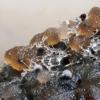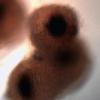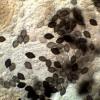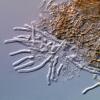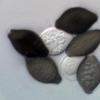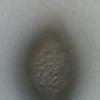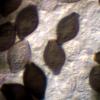
26-12-2025 21:19
Arnold BüschlenPithyella chalaudii Priou. Ist als Bryoparasit in

21-12-2025 09:32
Hello.A tiny ascomycete found embedded in wood in

18-12-2025 21:17
Pol DebaenstThe identification took me to Byssonectria deformi

24-12-2025 17:08
Hulda Caroline HolteHello, I have found this propoloid ascomycete on

21-12-2025 21:32
Pol DebaenstHello, Garden, Burgweg 19, Veurne, BelgiumOn 10/1
Melanospora-like mystery
Chris Yeates,
01-04-2021 16:11

The recent thread between Malcolm Greaves and Paul Cannon re a possible Melanospora species reminded me of this collection, over 2 years ago. Annoyingly I'm not sure whether I kept any material, so it is possible that these images are all the evidence.
The perithecia were around 350µm diameter and did not have a neck, but there was a darkened area around the ostiole, associated with some hyaline hyphae (see image). I did not see any asci, so don't know whether they were 4- or 8-spored. The ascospores were limoniform, with, I think, 2 ostioles, one of them more obvious than the other. They measured 18.1-20.1 x 9.8-12µm, and were very finely ornamented with low warts - see photo - this shows the surface, not internal contents. I doubt I would have observed this subtle feature were it not for DIC illumination.
The Mycokeys paper on Melanospora and its relatives came out after I had looked at this, so I have now gone through that but it hasn't made things clearer - Melanospora verrucispora is clearly a very different fungus. I don't have access to "A re-evaluation of Melanospora Corda and similar Pyrenomycetes, with a revision of the British species" in Botanical Jounal of the Linnean Society 84(2), February 1982; I suspect that is where Paul described his species.
I am not optimistic, but any comments would be interesting.
Chris
Paul Cannon,
01-04-2021 16:37
Re : Melanospora-like mystery
This could be a Melanospora, but my guess is that it belongs to Zopfiella - historically considered as non-ostiolate counterparts to Podospora sens. lat. It's difficult to be sure from your images (beautiful though they are) but the spores look as if they may once have had a hyaline basal cell - they collapse very easily in some species. If you do come across this again, I'd be happy to look at it.
In the mean time I shall send you a couple of historical papers...
Best wishes
Paul
Chris Yeates,
01-04-2021 18:27

Re : Melanospora-like mystery
Many thanks Paul - very helpful. I can see that the ends of the spores are dissimilar - nipple like at one end and truncated at the other, often with a hint of a hyaline "bump".
The papers are very interesting, I shall read them in depth later, but I love the idea of so many of these fungi on wine corks! I hate the use of these "corks" made from "renewable polymers derived from sugarcane". I have fond memories of the cork forests on Sardinia https://www.giarasardegna.it/en/content/cork-oak-forest - extremely biodiverse, with little need to mess with the native ground flora, and the cork is also renewable! These forests are slowly disappearing . . .
Chris
Paul Cannon,
01-04-2021 19:07
Re : Melanospora-like mystery
The sampling from wine corks is most enjoyable, regrettably I wasn't involved in all the practical work...
Michel Delpont,
01-04-2021 20:34

Re : Melanospora-like mystery
Good evening Paul.
Could I also have the papers you're talking about?
Thanks in advance.
Michel.
